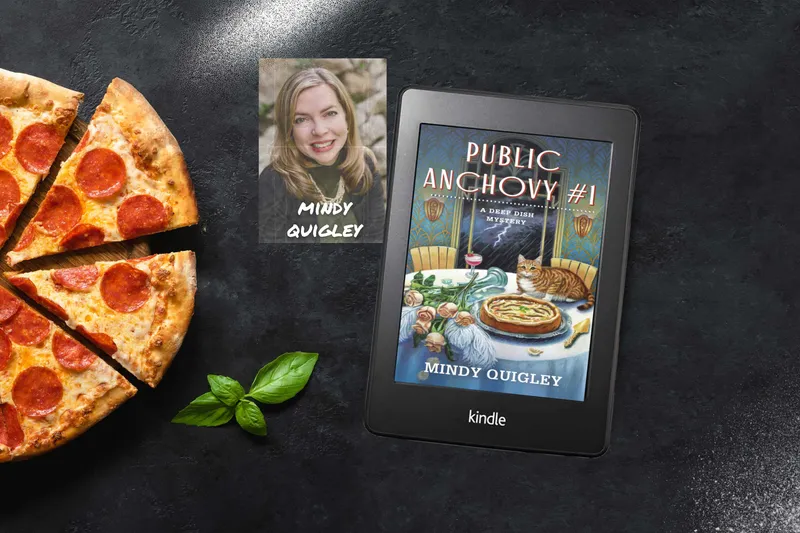Mindy Quigley is the author of two cozy mystery series. Her latest, the Deep Dish Mysteries (St. Martin’s Press), is set in the charming lakeside resort town of Geneva Bay, Wisconsin—a millionaires’ playground that serves up death by the slice.
Mindy’s non-writing career has been stranger than fiction, taking her from the US to the UK, where she worked as the personal assistant to the scientist who cloned Dolly the sheep, and as project manager for a research clinic founded by the author J.K. Rowling.
She lives in Virginia, with her Civil War history professor husband and their children.
Could you tell us briefly what your latest book, Public Anchovy #1, is about?
Mindy Quigley: In writing the Deep Dish Mysteries, I’m aiming for a modern spin on the cozy mystery genre—all the elements of a cozy, but with some fresh themes and characters whose attitudes and concerns reflect contemporary issues. With Public Anchovy #1, I thought it would be fun to see what happened if I threw my characters into an And Then There Were None-type setting that relies heavily on the classic “It was a dark and stormy night…” trope. Basically, drop a modern, quirky cast of characters into the epitome of a murder mystery cliché.
Delilah O’Leary and her crew are hired to cater a Prohibition-themed fundraising dinner in a remote mansion and end up trapped there when the weather takes an unexpectedly harsh turn. A dead body (literally) crashes the party and the tension ramps up when they realize that the killer is among them.
I was delighted when Kirkus Reviews said the book evoked “shades of Agatha Christie in a modern whodunit” because that was exactly what I was going for.
From pizzerias to ice cream parlours, bakeries and chocolate shops, cozy mysteries revolving around food are a popular sub-genre. What is the appeal for you of writing about a culinary sleuth?
MQ: I’m so glad you asked this question! Culinary cozies are pretty weird when you think about it, right? A rich buttery pizza crust…and a corpse. Zesty marinara sauce…and a corpse. The mouthwatering decadence of melting mozzarella…and a corpse. Weird!
I have some theories about why it works, though. Food is a way to connect with being alive—the pleasure of a sensory experience is available only to the living. It’s also highly linked to emotion. We eat our feelings. We don’t smell our feelings or dance our feelings, we eat them.
The same way that a boot kick of lemony acid can cut through the sweetness of a meringue, a little soupçon of murder really livens up a culinary mystery. Food reminds us of the joys and pleasures of life. Death is the shadow that brings everything into sharper relief.
Plus, pizza just makes everyone happy. Eating pizza is often a collective experience, and it’s associated with parties and childhood memories. Mixing death with that creates an automatic tension.
If you could have lunch with one of your characters, which one would it be and why? And where would you choose to meet for lunch?
MQ: Sonya Dokter, for sure. She’s the BFF and sous chef of my main character, Delilah O’Leary. I realized at some point that the two women represent two dominant parts of my personality. While Delilah’s perfectionism can sometimes make her pretty hard on herself, and, by extension, those around her, Sonya is much more of a live-in-the-moment kind of gal. She loves puns and brings humor, even in darker moments. Don’t get me wrong, I love Delilah, too. She’s loyal and brave and she’s a badass in ways that I envy. Sonya and Delilah are a great yin-yang combo. They complement each other’s strengths and support one another unconditionally.
Sonya and I would eat at Delilah & Son, the upscale deep-dish pizzeria where my books are set. When I was dreaming up the setting, I took the opportunity to create my perfect restaurant. It’s small and intimate, with modern décor and an eclectic flair. Best of all, it has a huge patio that’s right on the shore of a stunning lake. Everything on the menu is something I’d want to eat. The books include recipes, which are written from the point of view of different characters, and I test all of them to make sure they’re things I enjoy.
While writing your book, what was the most surprising thing you discovered or learned?
MQ: Writing a series under contract with a big publishing house is a BEAST of a thing to do. There came a point the summer before last when I was getting blasted with promo requests for the launch of book one at the same time I was editing book two while also writing frantically to meet my deadline on this book. Because of the glacial nature of the business side of publishing, at that point, I hadn’t yet received a single royalty check. So I was working like an absolute maniac for no money, while still trying to maintain my day job, my household, and my sanity. For a little while, sanity was the thing that was not being maintained. And I don’t mean that in a cute “Gee whiz, what a wild ride!” way. There was therapy. There were drugs.
Over the past year, I’ve recalibrated a lot of my priorities and expectations. When I signed the contract for Deep Dish books four through six earlier this year, I negotiated longer deadlines. Funnily enough, I managed to write book four in the same amount of time as the previous three, but not being under the gun meant that it was much less painful to write.
When it comes to plotting your novels, do you have the whole book outlined before you write? Do you use any specific strategies or techniques?
MQ: I learned, through bitter experience, that I am not a pantser. I tried to wing it with the plot of Public Anchovy, figuring that I knew the basics (whodunnit, whydunnit) and could fill in the rest as I went along. I ended up wasting a lot of time—time that I didn’t have—trying to write my way into the story. From now on, I’m Team Plotter!
I’ve used a few different techniques for plotting (storyboarding, notecards, Word document outlines, Save the Cat, etc.), but one thing that’s stayed pretty consistent is my actual writing process. I write in pomodoros of fifteen to sixty minute increments, depending on my schedule and my attention span. I usually turn on my Spotify playlist, which allows me to tune out and drop into the story. I gave Delilah and Sonya a similar playlist they use to get into the mood to cook.
What object in your writing space helps to spark your creativity and why?
MQ: Usually getting out of my writing space is what sparks creativity. Going for a walk, talking through a hairy plot tangle with a friend or fellow author, taking a shower. I really need to start keeping a waterproof notebook in the shower because some of my best ideas emerge in there.
What was the best writing advice you’ve ever received?
MQ: Years ago, I read Zen and the Art of Motorcycle Maintenance at the urging of an ex-boyfriend. Man, I hated that book. It was needlessly complicated, disjointed, and up itself. Kind of like that ex-boyfriend.
However, there’s a part in there about gumption that I think about all the time. Here’s the gist: your motorcycle is in pieces all over the ground. A bolt here. A nut there. You don’t know how you’re going to put it together. That’s a hard place to be. But you have to remember that the only thing between you and having a working motorcycle is your persistence in assembling the motorcycle. Even if you do it wrong and have to take it apart a dozen times, even if you have to ask someone to help you, or stop for a month and take a class on motorcycle engine repair, there is nothing stopping you from putting it together other than your willingness to come back again the next day and keep working on it.
The gumption story wasn’t specifically meant as writing advice, but for me, it’s been relevant. Even if you have to delete an entire subplot or rewrite your whole book over and over or put it aside for a \ year while you deal with a health crisis, you will finish it if you can make the time and you have gumption.
Last, but not least, what’s your favourite pizza?
MQ: I love all pizzas and every topping, except green peppers, which I merely tolerate. If I have to pick just one, it would be Lou Malnati’s “Deep Dish Lou.”
Actually, it would be an Aurelio’s thin-crust with spinach, tomatoes, and black olives.
Ooh! I forgot about Pizzeria Portofino’s Gorgonzola Dolce & Pancetta. Okay, clearly I can’t pick just one.
Visit Mindy Quigley on social media!

About Vanessa Westermann
Vanessa is a Canadian crime writer. She is the author of Cover Art and other books. At the heart of all of her stories are strong female protagonists.

